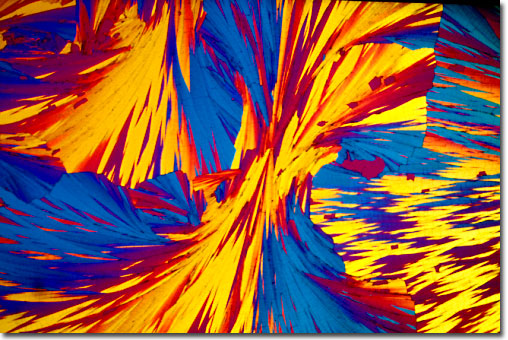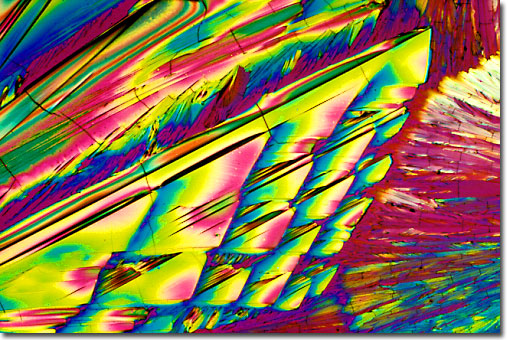 So breeding out wildness and breeding in tameness changes the body
chemistry in such a way as to reduce the production of all the metabolic
products of Phenylanine and Tyrosine, including Adrenalin, Dopamine, Serotonin,
Oxytocin, and Melanin.
So breeding out wildness and breeding in tameness changes the body
chemistry in such a way as to reduce the production of all the metabolic
products of Phenylanine and Tyrosine, including Adrenalin, Dopamine, Serotonin,
Oxytocin, and Melanin.
Some time ago, I saw an episode of Nova on PBS that was all about Man's Best Friend.
One of the interesting tidbits of scientific data had to do with breeding wolves (and dogs) to be tame.
As successive generations became tamer, their coat color also lightened up.
Whyizzat?
Turns out that wildness/tameness has to do with conditioning the Fear Response. When an animal is in the wild, things are a lot more dicey, a lot more dangerous. The Fear Response System pumps a lot more Adrenalin in a wild animal than in one that is tame and docile.
As the body's need for stores of heart-pumping adrenalin subsides, the metabolism of adrenalin production eases back proportionately.
Adrenalin, like all proteins and neuropeptides, is assembled out of Amino Acids -- the building blocks of life. There are about 22 Amino Acids. They are like the letters of the alphabet. And, like the letters Q and X, some are found in only a few unusual words (like Quixotic and Toxique). Two Amino Acids in particular go into the making of Adrenalin: Phenylalanine and Tyrosine. Phenylalanine is an essential Amino Acid, meaning we obtain it through dietary intake. Tyrosine is a nonessential Amino Acid that is synthesized in the body from Phenylalanine.
But Tyrosine has other uses in the metabolic life of the animal. It's also an essential building block of Dopamine, Oxytocin, and Melanin. It also plays a role in the production of Serotonin.
Melanin? Why ain't that the pigment that turns your skin and hair dark?
Why it sure is.
 So breeding out wildness and breeding in tameness changes the body
chemistry in such a way as to reduce the production of all the metabolic
products of Phenylanine and Tyrosine, including Adrenalin, Dopamine, Serotonin,
Oxytocin, and Melanin.
So breeding out wildness and breeding in tameness changes the body
chemistry in such a way as to reduce the production of all the metabolic
products of Phenylanine and Tyrosine, including Adrenalin, Dopamine, Serotonin,
Oxytocin, and Melanin.

In humans, redheads are way over-represented in Math, Logic, Science, Philosophy, and Comedy.
Whyizzat? High levels of Adrenalin (Epinephrine) are associated with Athleticism and Anxiety. Low levels of Adrenalin are associated with Scholarship and Coolness. And one of the markers for that is the associated low levels of Melanin -- e.g. redheadedness.
If you watch that PBS Nova episode, you will notice something remarkable. About half the scientists and dog-lovers featured on the show are blonds and red-heads. As are the tamer breeds of dogs and wolves.
Socrates, Galileo, and Darwin were redheads. So was King David, Vincent van Gogh, Mark Twain and Thomas Jefferson. Queen Elizabeth I and Winston Churchill were redheads. The legendary King Arthur was said to be a redhead. JK Rowling is a redhead. So is Jane Goodall.
For years I've wondered why so many of the people who share my interest in science, math, philosophy, comedy, and the bardic arts were redheads like myself. On the other hand, redheads make lousy soldiers, since soldiers need lots of Adrenalin. There was only one notable redheaded General in American history, and he was one of the worst Generals the US Cavalry ever had. His name was George Custer.
Now I have a credible theory to explain why there have been so many redheads in the forefront of the cerebral arts.
Here are photomicrographs of Tyrosine and Phenylalanine:

Tyrosine
Hydroxyphenyl Amino Acid that is used to build neurotransmitters and hormones.
Tyrosine is metabolically synthesized from phenylalanine to become the para-hydroxy derivative of that important Amino Acid. This hydroxylated Amino Acid participates in the synthesis of many important biochemicals including the thyroid hormones, the melanin biological pigments, and the catecholamines, an important class of biological regulators. Tyrosine is incorporated into proteins and enzymes at the molar rate of 3.5 percent with respect to the other Amino Acids.

Phenylalanine
Most common Aromatic Amino acid found in proteins.
Phenylalanine is an essential Amino Acid that is also one of the aromatic Amino Acids that exhibit ultraviolet radiation absorption properties with a large extinction coefficient. This characteristic is often used as an analytical tool to quantify the amount of protein in a sample. Phenylalanine plays a key role in the biosynthesis of other Amino Acids and some neurotransmitters. It is the most commonly found aromatic Amino Acid in proteins and enzymes with a molar ratio of 3.5 percent compared to the other Amino Acids, about double the amount of any other aromatic Amino Acid.
Micrograph Sources: http://micro.magnet.fsu.edu/aminoacids/index.html